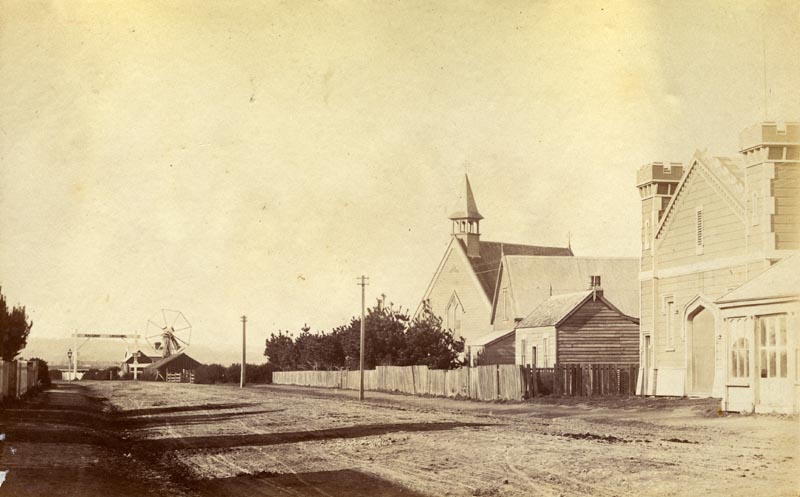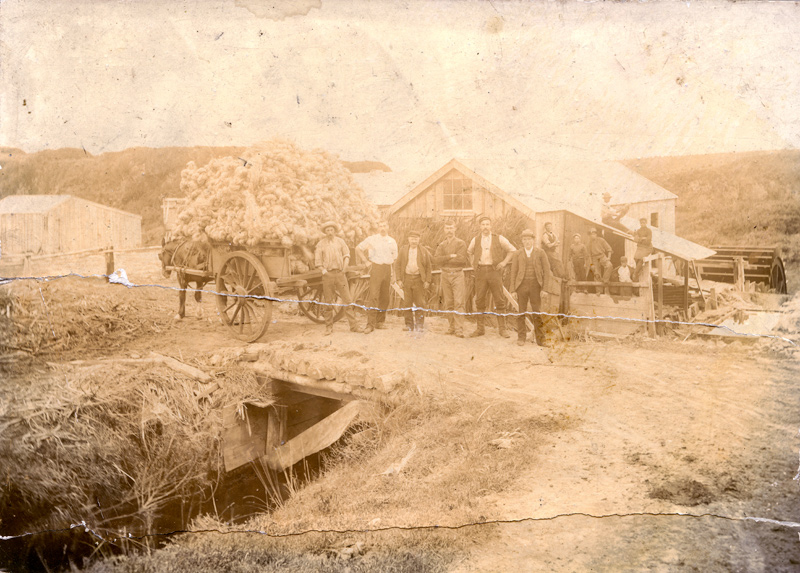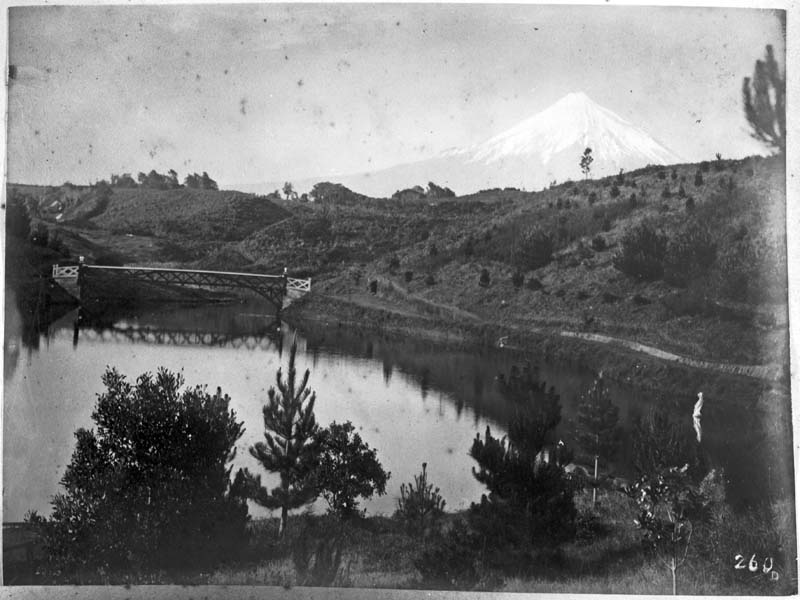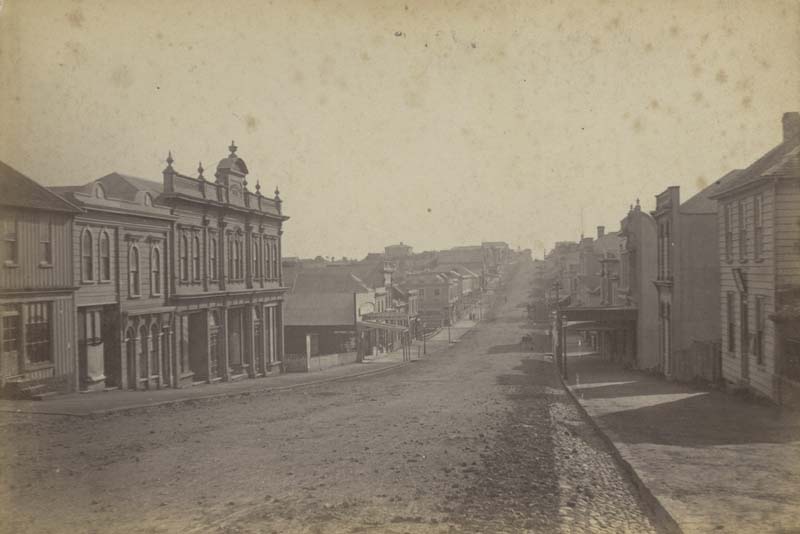





Have you ever wondered what a Taranaki travel book dated 1885 might have offered to the traveller by way of sightseeing tips?
The Illustrated Guide to the West Coast of the North Island, N.Z. rests in a glass case in the Puke Ariki Taranaki Research Centre. Written by R.W. Pownall in 1885, it is illustrated by drawings by W. Potts, from sketches by the author.
But a different name appears at the top of the front cover, that of Mr W.H. Smith. And though people by the name of Smith turn up all over the place, it's interesting to ponder the fate of this man who scrawled a mark of ownership across the booklet. What would he have made of Pownall's helpful Introductory?
“Introductory.
“If a party wishes thoroughly to enjoy a trip along the West Coast of this Island, by far the better plan is to have a conveyance, or better still, buy horses at any of the sale yards on the coast, where they will get hacks quite good enough for from £12 to £20 and perhaps obtain nearly as much for them when no longer required. By this means, they will enjoy the scenery along the roads, can strike into bye- paths and visit nooks and corners a vehicle cannot get to, and moreover, the feeling of absolute independence and liberty is worth something; besides, good hotels are always within reach and if ladies form part of the expedition, they can rely on politeness and civility all over the coast. Even the natives now will do most obliging things for a lady. As for luggage, that can easily be sent by rail to a central spot, but very little impedimenta is really required. Everything can be purchased nearly as cheap on the coast as it can in England, and it is astounding how little one can manage with.”
One good piece of advice to all strangers is – “keep just above the ripple on a water fall and have a good pole to sound with, but, better still, cross by a bridge whenever you can”.
So, did Mr W.H. Smith get to visit Taranaki, beginning his journey as the good guide suggests, at the bustling town of Whanganui and taking in the sights along the way?
Today, there's no way of knowing, but the small booklet makes interesting reading, nonetheless. And it's not difficult to picture the old landscape the way it's vividly depicted in the pages.
“Whanganui to New Plymouth.
“The traveller leaves Wanganui by the Northern Road and ascends the long hill bordered by the loveliest fern gullies, every now and then catching glimpses of the blue Pacific - down the hill again to the hamlet of Kai Iwi, with its pah, one hotel, station and sprinkling of houses; up again to the table lands, past Maxwellton [Maxwell], Nukumaru, Waitotara to Waverley, where now all is a smiling country.”
It was not too many years earlier that the New Zealand Wars of the 1860s had devastated people and the land, destroying all hope for some.
The graves of the many soldiers and settlers who died during the fighting could still be seen on the countryside wherever the battles took place - on the sand hills at Nukumaru, and at numerous places right on the way to Pātea, or Carlyle, as it was once known.
But that didn't stop Pownall penning a word portrait of places just waiting to be seen. Mount Taranaki, or Mount Egmont as it was called then, could hardly pass unnoticed. Neither could the grand buildings of Hāwera, which would be razed by fire in 1888.
“Leaving Patea, Kakaramea, a flourishing township, is next passed, then Manutahi, another township with a large population surrounding it – and thence by a most beautiful drive to Hawera, from which locality the first glimpse of Mount Egmont is obtained in its full grandeur, from peak to base.”
In Hāwera, the streets are well laid out, and the Government Offices, Post, Telegraph and Court House are well-built, and, though of wood, are pretentious structures. Hāwera is considered a “very gay inland town, and possesses a great name on the coast for hospitality and amusement”.
“Leaving Patea, Kakaramea, a flourishing township, is next passed, then Manutahi, another township with a large population surrounding it – and thence by a most beautiful drive to Hawera, from which locality the first glimpse of Mount Egmont is obtained in its full grandeur, from peak to base.”
In Hāwera, the streets are well laid out, and the Government Offices, Post, Telegraph and Court House are well-built, and, though of wood, are pretentious structures. Hāwera is considered a “very gay inland town, and possesses a great name on the coast for hospitality and amusement”.
From Hāwera to Opunake, a well-kept high road followed the coastline, with Mount Taranaki tall and clean on the traveller's right. Readers are assured of a pleasant coach ride through the Waimate Plains.
According to the booklet, there are numerous “native pahs” and thriving European homesteads along the way, though the author complains about the lack of pit stops along the way.
Every now and then, when the clematis is in flower, the rest of the bush bright with the wealth of native flowers and you get a constant succession of picturesque bits, it is rather aggravating as the coach rolls remorselessly on without regard to the landscape.
But pulling into busy Manaia, he pauses to make a few optimistic observations before moving on towards Opunake. There are several hamlets on the road, but Manaia is the only place approaching a township, and the streets seem thronged, chiefly with Māori.
Otākeho and Ōeo are merely hotels and stores, the latter not even having a post office. But the wealth of the plains is in the rich land that abounds, affording, as it will do in the future, work to thousands.
For some reason, Pownall decides there is little to see en route to Opunake, except the ubiquitous “Maori pahs and a few deserted redoubts”. But he considers the rivers beautiful and comments on how they would make fine trout streams.
And, of course: “There is Egmont, always grand on your right, and very considerably changed in shape he is by the time you arrive at Opunake”. He also urges the traveller to call in at the local Armed Constabulary.
“onsists at present of two hotels, Prosser's and Middleton's, several stores, Court House, Post and Telegraph Office, and Government Schools.
There is a large farming community round, and the settlement of most of it is so recent that one cannot say much of its capabilities as an agricultural district. There is a flax mill, a cordial manufactory and a brewery.
But the chief beauty of the place consists in its harbour, a bay of no very great size, but capable of being made with a small outlay the emporium of the whole district…”
“…The Southern side of the harbour is crowned by the Armed Constabulary redoubt. It is worth a visit; the men's quarters are clean, the clematis has been trained over the walls, and has a cheerful appearance; the men have a reading room and a library and own a boat in which they indulge excursions.”
After Opunake comes Rahotū, with its “Hotel, house and one abandoned redoubt”. Then it's Pungarehu, with Parihaka just up the road. Ōkato is not mentioned and neither is Ōākura, then it's off down the road.
On the west coast of the North Island, New Plymouth is the jewel in the crown, and the booklet notes those sights that might keep a visitor there.
“The town of New Plymouth contains much that is of interest to the traveller. Here is a church, built by the troops, and numerous monuments and graves, which speak for those who fell fighting the Maori and who are now almost forgotten. The Gardens and Lake are still in their infancy, but will repay a visit, and some day will form the showplace of the province…”
“…At present, New Plymouth has over three thousand inhabitants. The soil is exceedingly fertile, and there is a great deal of land yet open for settlement. All round the slopes Mount Egmont, the rich volcanic soil will amply repay whoever settles on them, and if at present the district is languid, it is because the population is so sparse.
“Vine-growing will no doubt be a flourishing industry at some future date; at present there is very little carried on. Tobacco of a very superior quality can also be grown with considerable profit. The timber will prove of great value in the future, as the farther back the settler goes into the ranges the more superior is the quality of the timber.”
And there we'll leave the informative and entertaining Illustrated Guide to the West Coast of the North Island, N.Z., with its curiously Anglicized and romantic drawings of early Taranaki.
It has taken us safely from Whanganui to New Plymouth, and though it somehow manages to contain travel tips for the deep interior - Lake Taupō and Mt Ruapehu - back into the glass case it goes, to be pulled out perhaps in another century or two.
Pownall, R.W (1885). Illustrated Guide to the West Coast of the North Island, N.Z. Whanganui: A.D. Willis.
Please do not reproduce these images without permission from Puke Ariki.
Contact us for more information or you can order images online here.